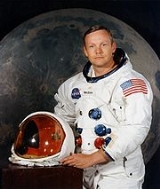
Neil Armstrong
Overview
Neil Alden Armstrong (born August 5, 1930) is an American former astronaut
, test pilot
, aerospace engineer
, university professor, United States Naval Aviator
, and the first person to set foot upon the Moon
.
Before becoming an astronaut, Armstrong was in the United States Navy
and served in the Korean War
. After the war, he served as a test pilot at the National Advisory Committee for Aeronautics
(NACA) High-Speed Flight Station, now known as the Dryden Flight Research Center
, where he flew over 900 flights in a variety of aircraft.
Astronaut
An astronaut or cosmonaut is a person trained by a human spaceflight program to command, pilot, or serve as a crew member of a spacecraft....
, test pilot
Test pilot
A test pilot is an aviator who flies new and modified aircraft in specific maneuvers, known as flight test techniques or FTTs, allowing the results to be measured and the design to be evaluated....
, aerospace engineer
Aerospace engineering
Aerospace engineering is the primary branch of engineering concerned with the design, construction and science of aircraft and spacecraft. It is divided into two major and overlapping branches: aeronautical engineering and astronautical engineering...
, university professor, United States Naval Aviator
United States Naval Aviator
A United States Naval Aviator is a qualified pilot in the United States Navy, Marine Corps or Coast Guard.-Naming Conventions:Most Naval Aviators are Unrestricted Line Officers; however, a small number of Limited Duty Officers and Chief Warrant Officers are also trained as Naval Aviators.Until 1981...
, and the first person to set foot upon the Moon
Moon
The Moon is Earth's only known natural satellite,There are a number of near-Earth asteroids including 3753 Cruithne that are co-orbital with Earth: their orbits bring them close to Earth for periods of time but then alter in the long term . These are quasi-satellites and not true moons. For more...
.
Before becoming an astronaut, Armstrong was in the United States Navy
United States Navy
The United States Navy is the naval warfare service branch of the United States Armed Forces and one of the seven uniformed services of the United States. The U.S. Navy is the largest in the world; its battle fleet tonnage is greater than that of the next 13 largest navies combined. The U.S...
and served in the Korean War
Korean War
The Korean War was a conventional war between South Korea, supported by the United Nations, and North Korea, supported by the People's Republic of China , with military material aid from the Soviet Union...
. After the war, he served as a test pilot at the National Advisory Committee for Aeronautics
National Advisory Committee for Aeronautics
The National Advisory Committee for Aeronautics was a U.S. federal agency founded on March 3, 1915 to undertake, promote, and institutionalize aeronautical research. On October 1, 1958 the agency was dissolved, and its assets and personnel transferred to the newly created National Aeronautics and...
(NACA) High-Speed Flight Station, now known as the Dryden Flight Research Center
Dryden Flight Research Center
The Dryden Flight Research Center , located inside Edwards Air Force Base, is an aeronautical research center operated by NASA. On March 26, 1976 it was named in honor of the late Hugh L. Dryden, a prominent aeronautical engineer who at the time of his death in 1965 was NASA's deputy administrator...
, where he flew over 900 flights in a variety of aircraft.
Unanswered Questions
Discussions
Quotations
I think we're going to the moon because it's in the nature of the human being to face challenges. It's by the nature of his deep inner soul ... we're required to do these things just as salmon swim upstream.![]()
Apollo mission press conference, quoted in Of a Fire on the Moon (1970) by Norman Mailer, and in First Man: The Life of Neil A. Armstrong (2005) by James R. Hansen
Houston, Tranquility Base here. The Eagle has landed.![]()
First words from the Apollo 11|Apollo 11 Lunar Landing Module Eagle after guiding the craft to a landing on the moon. It is estimated that there was 11 seconds' worth of fuel left at touchdown. (20 July|20 July 1969|1969)

